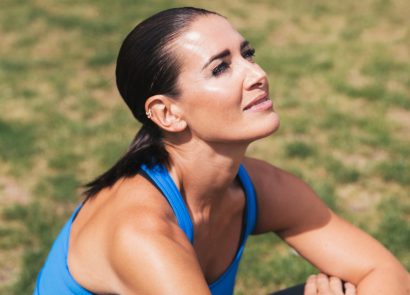Losing weight the healthy way is much simpler than the diet industry might have led you to believe. The key markers of a healthy weight loss journey are slow, sustainable, and long-term. Building healthy eating habits and incorporating physical activity into your daily routine are the most important factors when it comes to reducing your body weight. When we start restricting ourselves, sometimes diets can do more damage than good.
Building a healthy diet plan for weight loss
It’s safe to say that COVID-19 plunged our world into chaos. Back in March 2020, offices up and down the UK were forced to lock up their beige filing cabinets and decamp – and many of us are still tapping away at the kitchen table. But while working from home has its benefits, unlimited access to the fridge may lead to a spike in life-threatening illnesses, including obesity and liver disease. A new YouGov survey commissioned by the British Liver Trust has revealed that 42 percent of people in the UK admit to gaining weight since lockdowns first began, with a third of people also claiming that they’re eating more sugary and processed foods than usual.
Time to dust off the diet plan, right? Wrong. Like everything else right now, diets are all about sustainability, so here’s how to lose weight the modern way, and, spoiler alert – there’s no diet pills involved, and no Body Mass Index (BMI) either; just a healthy lifestyle change.
Assess why you think you should diet
Raise your hand if you’ve ever been on a diet. If you’re sheepishly putting yours up, you’re certainly not the only one. It’s said that women and men across the UK spend an enormous amount of time trying to lose weight, with two thirds of Brits admitting that they’re on a diet ‘most of the time’. So what makes us decide to change our eating habits in the first place? Dr Juliet Rosewall, a clinical psychologist and co-author of Heal Your Relationship with Food, believes it’s because a slim physique for women is portrayed as desirable. “This means that being in a larger body is judged and that it’s something to be ashamed of, which leads to negative attitudes [and the belief that] a smaller body equals happiness and success.” Toxic body shaming doesn’t exactly sound like the ideal way to spark a positive new eating plan, does it?
Don’t get confused by weight loss compliments
We all love receiving compliments, be it a comment on your new haircut or an outfit that someone admires. Well, the same goes for weight loss. Although well-intended, commenting on a person’s weight and associating that with an aesthetic quality can sometimes do more harm than good, according to Dr Rosewall. “When someone says, ‘Wow, you look great – have you lost weight?’ it can be problematic, especially if they have used unhealthy or extreme methods to acquire this body shape. By focusing on that, we are inadvertently reinforcing the belief that a person is only valuable or worthy of praise if they’re a certain weight or shape.” So, how do we start formulating more constructive compliments? “When commenting on others, try to highlight the positive parts of their personality, or the things about them that actually matter – not just their appearance.”
The yo-yo effect of diets
All too often, diets promise structural freedom and control when, in fact, experts warn that they can be unbalanced nutrition plans that encourage individuals to develop an unhealthy relationship with food. “Just like drug addiction, people can develop an obsession with food, and when people try to cut out certain food groups, for example, they can experience similar withdrawal symptoms and behaviours [as addicts],” explains Dr Deborah Lee, health writer and doctor at Doctor Fox Pharmacy. “Food cravings associated with calorie restriction are a common reason for sticking to the diet in the first place, thus resulting in increased levels of stress, anxiety and depressive symptoms – especially if we fail to lose weight and give up again.”
Studies have also shown drastic fluctuations caused by severe dieting such as the sirtfood diet can result in serious health problems. “Weight loss is often short and comes at a cost,” warns Dr Rosewall. “After going on a diet, the weight is regained back to pre-diet levels and sometimes more. Not to mention the detrimental psychological effects of being on a diet, which is a failure of the unrealistic demands of dieting – not you.”
Don’t get caught in a diet trap for weight loss
Reducing your calorie intake is traditionally one of the first steps to lowering your number on the scales and, when done well, isn’t normally a problem. It’s the restrictive diets that pose a real threat to our overall health and wellbeing, says Holly Wilkinson, qualified nutritionist for Jimmy Joy. “In this case, very restrictive diets can cause malnutrition due to a lack of vital nutrients, and even go so far as to cause harm to our mental health, too. Some fad diets tend to demonise certain food groups, such as sugar, grains or even fruit, risking a skewed view on balanced nutrition.”
Registered nutrition consultant Jenna Hope agrees. She says that eating too little can cause your body to go into overdrive and start craving foods you’ve eliminated. “When the body is not provided with enough energy, it will find other ways to conserve it. Therefore, it may slow down its metabolism and actually hold onto fat stores, while reducing non-exercise thermogenesis – the name given to small movements, such as twitches or fiddling.”
Find your food freedom
Dieting is part of our culture – the industry is worth £2 billion, after all. But we can shift the focus onto eating wholesome, nutritious food rather than weight loss, and learn more about what our body really needs and overall weight maintenance. The 80/20 approach is one that Holly would recommend as a good all-round method. “Understand that no food is off limits, but know that the body depends on certain foods to thrive. Focus on eating more of the good stuff instead of the junk. You can still enjoy all of your favourite foods, but make sure that the bulk of your diet is designed to make you feel good inside and out.”
“Foster self-compassion for the body you have and what it does for you,” suggests Dr Rosewall. “This may or may not result in weight loss, but by doing this, you can trust that your body and mind will be healthy, and that you will be free from the punishment that comes from trying to change it.”
Good food : how to get your fill
Jenna Hope believes that food should be enjoyable and nutritious – not boring. Here, she shares her tips for a nourishing and fulfilling approach to weight loss.
- Consume a diet focused around whole foods, such as whole grains, vegetables, meat and dairy.
- Diet and exercise go hand in hand, so ensure you schedule a good workout plan into your weekly routine.
- Believe it or not, the odd chocolate bar and glass of wine are key components to a healthy relationship with food.
- View all food as equal to prevent having strict rules around food groups.
- Restricting calories can lead to tiredness, blurred vision and low energy, so ensure you’re eating enough of all foods as part of a healthy diet.
The food group you should never ignore for weight loss: fibre
While intermittent fasting and the keto diet may have been in the news a lot lately, nutritionists have recently hailed the need for good fats in our diet (which ignited our love affair with superfood avocado). But how many of us actively seek to consume 30g of fibre?
Fibre is an important part of a balanced diet and comes packed with health benefits, helping to ward off heart disease, diabetes and maybe even some types of cancer. It is also fundamental for a healthy digestive system. This vital carbohydrate is found in plant foods; for example fruits, vegetables and whole grains. Often, it’s overlooked during meal times, but could your 30g daily allowance help you stay trim? Here’s why you should forget everything you think you know about low carb diets.
The benefits of fibre
It’s been common to link this nutrient to weight loss. A recent study found that those who ate their daily allowance of fibre but didn’t change their other eating habits lost almost as much weight as those who followed a heart-healthy, low-fat diet plan recommended by the American Heart Association. This study adds to a growing body of evidence that those who tend to eat more fibre have a healthier body weight. But before you start celebrating its magical fat-burning properties, you should know that the nutrient doesn’t melt excess pounds away by itself. Its trick is that it satisfies hunger for an extended period of time, without consuming ample calories.
The types of fibre
Essentially, fibre aids digestion and leaves you feeling fuller for longer. There are two different types: that which is soluble and that which is insoluble. Insoluble fibre ensures the digestive system runs smoothly, whereas soluble fibre aids weight management and reduces calorie consumption. “Foods containing soluble fibre can lead us to eat fewer calories,” nutritionist Amanda Hamilton explains. “Think of soluble fibre like a sponge. If you put water on it, it expands to nearly double the size. Therefore eating fibre-rich foods leaves you feeling fuller for longer as it soaks up liquid during the digestion process. Eat bulky fibre-rich foods to stay slim,” she concludes.
Soluble fibre also helps to balance your blood sugar levels which ensures your body is less likely to store fat. “Soluble fibre slows the emptying of the stomach’s contents into the intestines, meaning that carbohydrates and sugars from our foods (natural or otherwise) are absorbed more slowly, balancing blood sugar and energy levels as well as our appetite,” explains Henrietta Norton, nutritional therapist and co-founder of foodgrown supplement brand Wild Nutrition. “This is why eating whole fruit is better for us than drinking fruit juice, because the fibre in the whole fruit slows down the absorption of the sugars.”
As well as keeping our weight in check, it also helps to control cholesterol levels. “Soluble fibre helps bind cholesterol in the gut and ensures it is efficiently excreted from the body,” explains Henrietta. Soluble fibre is referred to as a prebiotic because it provides healthy bacteria to help the gut ferment. “Fibre also helps encourage the population of beneficial bacteria in the gut, ensuring good digestion. Plus, it also plays a major role in the normal function of our immune system,” Henrietta says. Couple this with the nutrient’s ability to balance hormones and you’re on to a winner. In fact, if there was such a thing as a supernutrient, fibre would definitely take the crown.
Fibre-rich foods
“Fibre should be obtained via a variety of sources and not just in high amounts from whole fruits,” Henrietta says. “If you eat too many whole fruits you’ll up the level of fructose in your diet which has been linked to weight regain,” she concludes. As with any food group, it’s all about balance. You need a good amount of both soluble and insoluble fibre. Furthermore, they should be consumed as part of a healthy diet.
The most common source of insoluble fibre is wheat bran, however other good sources include whole grains (such as brown rice, barley and rye), the skins of vegetables and fruits (especially root vegetables such as sweet potato and beetroot), nuts and seeds (particularly flaxseed), and lentils and other legumes (such as beans and chickpeas). Good sources of insoluble fibre include oats and the skin and rinds of fruits and vegetables. “The skins contain a type of soluble fibre called pectin which is thought to be especially good at controlling cholesterol levels,” Henrietta adds. Team your 30g of fibre with plenty of water to aid weight loss and help it pass through your digestive system. The NHS recommends we drink 1.2 litres, or six to eight glasses of fluid per day, and even more when exercising.
Achieving your weight loss goal
“The slimmer you are, the less weight you’ll lose because you’ll be burning fewer calories,” says nutritionist Dr Sarah Schenker. “Recognise that weight loss works in steps, so it will come off for a few weeks and then plateau, and then take a few weeks before it starts falling again. The key is not to give up and to see it as a long-term plan.”
Take a tip from professional athletes and rather than focus on what you can’t do, have a vision of what you can achieve. “Visualisation training improves the mental process and reinforces good habits, and enhances the current experience by building a stronger mindset,” says sport and exercise scientist John Beeby. “Athletes use this technique to create their own realities, and through the power of their own thoughts and feelings they overcome adversities and break through barriers.”
If visualisation is not for you, try looking at the problem from a new perspective. “The scale may not have moved but your clothes may feel looser, you may be able to exercise longer or harder, or just have more stamina,” says nutritional therapist Shani Shaker. “Consider the impact weight loss is having on your health, as well as your appearance – even the slightest loss will have a positive impact on blood sugar regulation, blood pressure and cholesterol levels.”
Keep track of your intake
You might think you’re keeping a beady eye on your calorie intake and expenditure, but it’s easy to underestimate how much you’re scoffing, or to overestimate a workout… and soon your waist circumference can creep up. “Diet lapses such as the odd glass of wine or a missed gym class can all cause a plateau,” says nutrition coach Susan Hart. “Get back to basics and log your food and activity on an app and you should get back on track.” And focus on those portion sizes, too. “Look on the packets, or find a good portion guide,” says dietitian Priya Tew. “Items such as nuts, dried fruit, pasta and cereals are easy to over-consume.”
Switch up your exercise routine
If you find yourself in a routine rut, try completing your gym regime back-to-front to make it more interesting, or, if you always exercise after work, get up earlier and do it in the morning. Small changes can make a big difference to motivation levels and keep muscles guessing.
“There’s nothing like exercising with a friend for keeping you motivated,” says dietitian Renee McGregor. “Put the date in your diary just as you would a social meeting and this will help get you out of the door.”
Pounding the treadmill in the same way every day, week in week out, is not only boring for you, but for your muscle mass too. As your muscles become more efficient at a certain exercise, they’ll burn less calories. Up the intensity with heavier weights, try interval training, or get a PT to devise a new routine. “By using what is known as ‘periodisation’ in your training you’re going to give yourself the best opportunity to continually progress and develop,” says John Beeby. “Because the body adapts, your training cycles should be adjusted every six weeks, and depending on the type of goal you have, base your six week plan specifically around this goal.”
Keep some perspective
Consumed by workouts and weight loss, you can easily forget how far you’ve come. Give yourself a mini thumbs up every few weeks to spur you into action again. “Take two days off and then start a brand new fitness routine, buy some new kit, or watch some inspirational movies – if others can overcome adversity, then you can overcome your plateau!” says Dr Rhona Cohen, sport and exercise psychologist at Middlesex University. “Set a reward for overcoming your plateau, such as a night out – if you want it, you’ll work for it.”
“Pick exercise and activities that excite and encourage your likelihood of continuing,” says John Beeby. “Not all exercise suits everyone so make decisions based on what you love. Training isn’t exclusively in a gym but could include dancing, swimming or playing tennis.”
We’ve all done it – we go to the gym and work out for an hour, only to come home and watch Game of Thrones on repeat! To maintain your weight and fitness long-term, you need to include incidental exercise into your day, on top of your workouts. “Walk to the bus stop or park further away from your office,” suggests dietician Dr Schenker. “Take the stairs rather than the lift or stand in a waiting room rather than sit down – all these things add up.”
It might sound counterintuitive, but if you want to get fit, you need to rest. Getting plenty of sleep and giving your muscles a recovery day is just as important as the number of reps you do. Have a day off each week and give yourself a full week of rest every six weeks. “Rest, re-fuel and be patient!” says Beeby. “It’s easy to push the body too hard and get frustrated when results aren’t achieved in two days. The reality is that true change takes time.”
Adjusting your portion size
Meat and fish portions
“When you’re cooking meat or fish and wonder how much you should be eating, the palm of your hand is a good guide to go by,” says nutritionist Frida Harju-Westman. “Men should have two palm-sized pieces of meat with their meal, while women should have one palm.” The same rule applies for other protein-rich foods, such as pulses or eggs.
Vegetable portions
“Many of us say we love healthy food, but most of us don’t actually consume as many vegetables as we should, so feel free to eat as many greens as you want and really make them the focal point of your plate,” Frida advises. “Ideally, your plate should have enough vegetables to match the size of two tennis balls.”
Cheese portions
“Cheese is a great, delicious way to satisfy your hunger, but it contains high levels of saturated fats and sodium, so you should try to limit how much you consume,” Frida warns. “Your cheese portion shouldn’t be bigger than two normal batteries.”
Carbohydrate portions
It can be easy to misjudge the portion size for carbohydrates. “Before you start boiling your rice or pasta, measure out a portion that matches the size of a tennis ball or your clenched fist, as that will be enough for one meal,” Frida explains. Carbohydrates are too often thought of as the base of a meal, so reverse this by putting them on last, and you’ll find that you’ll serve yourself less.
Portions of fats
“For fatty foods like butters, nuts and seeds, it’s recommended that your per meal portions don’t exceed the size of both of your thumbs,” suggests Frida. “While nuts and seeds are healthy snacks, you shouldn’t overeat them as they are still high in calories and can contribute to unwanted weight gain, so a handful per day is fine.” Ladies, this also applies to nut butter.
Should you eat smarter or train harder for weight loss?
It’s been said that you can’t ‘out-exercise’ a bad diet, but is this true? There are many people, celebs included, who claim they never watch what they eat, or think about their daily calorie allowance… they just exercise like a boss. But how effective is this in the war against weight loss?
According to the experts, the best results come from a routine based on 75 percent healthy diet and 25 percent working out. This suggests that exercising is not as important as our food intake. This is partly because it takes an awful lot of effort to work off those extra calories. Having said that, a healthy diet with reduced calorie intake may help you shed the pounds, but it’s not necessarily going to make you look toned without a complementary fitness routine. This is because you’re also losing muscle and bone density, as well as body and belly fat, which leaves skin looking saggy. So, although the number on the scales looks good, your general physique might not reflect that. In other words, if you want to fit into those jeans and create a slender toned silhouette, then you need to exercise, too!
But if this is the case, then why won’t exercise alone burn fat and give you a super-trim shape? According to a survey carried out by the nutrition clinic at the University of Utah, those who dieted for 15 weeks without exercising lost 23 pounds and those who exercised without dieting for 21 weeks lost six pounds. So exercising works, but not as well as when it’s combined with a diet plan. There’s no escaping the fact that it’s harder to burn extra calories than it is to consume less.
I’m an advocate for the ‘everything in moderation’ approach. In other words, if you make a few effective changes to your diet and exercise routine, then you should see results. The trick is in combining the two effectively. It’s a bit like balancing the spices in a curry. You want to make it tasty enough to be enjoyable, but not overly spiced so that it blows your head off and you never want to repeat the experience! On the flip side, if you don’t add enough spice then the results will be bland and nondescript. According to those in the know, a healthy balanced diet which includes lean proteins, whole grains and lots of fruit and veg is the ideal way to start. Add in a high-intensity, muscle-building workout such as spinning two or three times a week, and you should have the perfect recipe for success!
Should you be weighing yourself daily?
It’s easy to get carried away when you’re on a diet, watching each mouthful and charting every half a pound lost in a bid to be lean. It’s enough to send you loopy and reaching for the biscuit tin, so you’d think stepping on the scales every day would be a bad idea. Not so, according to a two-year study recently documented in the Journal of Obesity, which shows that it really is possible to weigh the fat away.
The study split 162 subjects into two groups, and found that those tracking and recording their weight every day not only lost more, but were also keeping it off in the long term. This group was given a target of one percent body fat loss per week, and it was a huge success, which researchers believe is down to the dieters making a connection between what they ate and the figure on the scales. Charting weight loss or gain every day meant that they thought more carefully about their diet and exercise regime, forcing them to make positive choices. So could this be the way forward?
Bear in mind that body weight fluctuates naturally depending on a number of factors, so a few pounds either way shouldn’t be a cause for alarm. It’s also worth remembering that muscle weighs more than fat. So while you might not appear to be losing on the scales, you could still be shedding inches and getting fit, and that’s definitely worth celebrating!






















